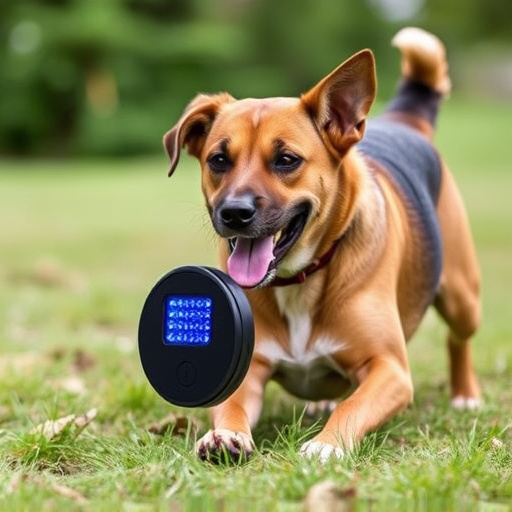Sound wave pet behavior control devices use specific frequencies to manipulate animals' senses without harm. The Best Vibration Settings Dog Repellent Device targets dogs' hearing with ultrasonic or infrasound waves, adjusting based on individual responses for effective training. Start at 20-50 Hz, monitor pet reactions, and customize settings for behaviors like barking or scratching, focusing on redirection in consistent sessions.
Unleash a new way to manage pet behavior with sound wave technology. From barking dogs to feline frisktiness, sound waves offer a humane and effective solution. This article delves into the science behind these devices, explaining how they work and why they’re gaining popularity. We explore ‘best vibration settings’ for maximum impact and provide practical tips for using dog repellent devices successfully. Train your pets with minimal stress and enjoy a quieter home.
- Understanding Sound Waves and Pet Behavior
- The Science Behind Dog Repellent Devices
- Choosing the Best Vibration Settings
- Effective Use and Training Tips
Understanding Sound Waves and Pet Behavior
Sound waves, with their ability to travel through air and water, are a fascinating aspect of our world. When it comes to pet behavior control, understanding sound waves can be a game-changer. These waves, created by vibrations, carry energy and can have distinct effects on living beings, including pets. By manipulating sound waves, certain devices can emit specific frequencies that impact an animal’s senses and behavior.
For instance, a Best Vibration Settings Dog Repellent Device utilizes this principle to deter dogs from unwanted areas. It emits high-frequency sounds or vibrations that are often inaudible to humans but can provoke an aversive reaction in canines. This innovative approach offers a humane alternative to traditional repellents, as it does not cause physical harm but rather trains pets through subtle sensory cues.
The Science Behind Dog Repellent Devices
Sound wave pet behavior control devices have gained popularity as a humane and effective way to train and manage animals, especially dogs. These innovative tools use specific sound frequencies to repel or guide pets, employing the science behind their hearing capabilities. Dogs, for instance, can detect sounds in a much wider range than humans, with some high-frequency sounds being inaudible to us but not to them.
The best vibration settings on dog repellent devices are designed to target this sensitive auditory range. By emitting ultrasonic or infrasound waves, these devices create patterns that can be unpleasant or even uncomfortable for dogs without causing physical harm. The specific tones and frequencies vary across models, with the most effective ones being adjustable to cater to different breeds, sizes, and behaviors. This adaptability ensures that pet owners can find the optimal vibration settings for their furry companions, fostering a safer and more harmonious living environment.
Choosing the Best Vibration Settings
When it comes to sound wave pet behavior control devices, choosing the best vibration settings is crucial for effective and humane training. These devices use ultrasonic or infrasonic waves combined with vibrations to modify behavior, but each pet has a unique sensitivity to these stimuli. Start by selecting a setting that’s within the range comfortable for your pet, typically between 20-50 Hz for most dogs. Adjustments can be made gradually from there based on your pet’s response.
For instance, if your dog shows signs of discomfort or avoids the area altogether, move to a lower vibration level. Conversely, if they seem indifferent, you might need to increase it slightly. The best Vibration Settings Dog Repellent Device should encourage positive behavior changes through consistent and gentle reinforcement without causing stress or harm. Regular monitoring and adjustments will ensure your pet associates the device with a positive outcome, effectively curbing unwanted behaviors.
Effective Use and Training Tips
For effective sound wave pet behavior control, mastering the device’s settings is key. Begin by identifying the specific issue—whether it’s training a dog to stop barking or keeping cats from scratching furniture. The best vibration settings vary based on the animal and behavior. Start with lower frequencies and intensities; these are often more effective for dogs as they can be startle them into modifying their behavior without causing discomfort. Gradually increase vibrations if needed, ensuring you don’t set it too high, which may only scare or stress pets.
Training is another crucial aspect. Teach your pet to associate the sound with a positive action. For instance, use the device when your dog barks excessively and reward them for quiet behavior immediately afterward. Consistency is vital; regular sessions over time are more beneficial than sporadic, intense ones. Remember, the goal is not punishment but redirection, so be patient and persistent in your training efforts.
Sound wave pet behavior control offers a non-invasive, safe solution for modifying pet behavior. By understanding sound waves and their effect on animals, dog repellent devices can be effectively used with the optimal best vibration settings to deter unwanted actions. With proper training tips, this technology can enhance your pet’s well-being and improve living environments. When choosing a dog repellent device, consider factors like vibration intensity and frequency to ensure it meets your specific needs.
